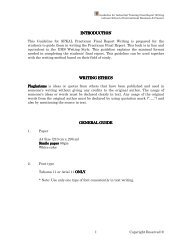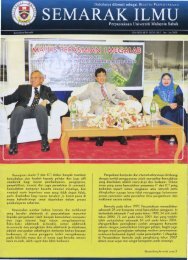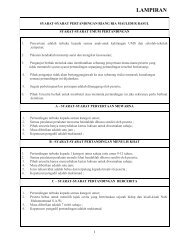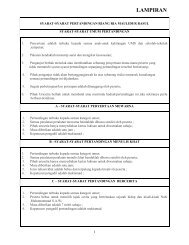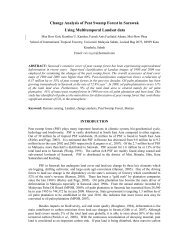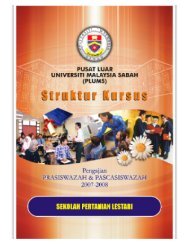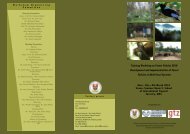ASSESSING WETLAND VEGETATION FRAGMENTATION IN ...
ASSESSING WETLAND VEGETATION FRAGMENTATION IN ...
ASSESSING WETLAND VEGETATION FRAGMENTATION IN ...
Create successful ePaper yourself
Turn your PDF publications into a flip-book with our unique Google optimized e-Paper software.
MRSS 2010, PWTC, Malaysia. April 28-29, 2009<br />
<strong>ASSESS<strong>IN</strong>G</strong> <strong>WETLAND</strong> <strong>VEGETATION</strong> <strong>FRAGMENTATION</strong> <strong>IN</strong> BEAUFORT,<br />
SABAH US<strong>IN</strong>G MULTITEMPORAL SATELLITE REMOTE SENS<strong>IN</strong>G<br />
ABSTRACT<br />
K.U. Kamlun 1 , M.H. Phua 1<br />
1 School of International Tropical Forestry<br />
Universiti Malaysia Sabah, 88400 Kota Kinabalu, Sabah, Malaysia<br />
Email: kamlisa@ums.edu.my<br />
Wetland is a part of natural ecosystem that provides many intangible services to human. The<br />
wetland in Beaufort, Sabah lays pieces of pristine peat swamp forest (PSF) that has been<br />
rapidly disappearing. This study aims at quantifying the wetland vegetation changes and<br />
fragmentation in Beaufort area from mid-80s to mid-2000s using multitemporal satellite data<br />
of Landsat MSS (1985), Landsat TM (1991), Landsat 7 ETM+ (1999), Landsat 7 ETM+<br />
(2003) and SPOT4-HRVIR (2003). The satellite images were classified into ten land cover<br />
types with supervised classification approach. The classification’s results show significant<br />
changes in peat swamp forest (PSF), bareland and grassland in the 18-year period. The PSF<br />
had plummeted by about 70% from 1985 to 2003. Mean patch size and largest patch index<br />
between 1985 and 2003 show an increase of fragmentation in the PSF. Mean nearest<br />
neighbor distance of PSF indicates that the patches of PSF have low connectivity and<br />
isolated. From the degrees of deforestation and fragmentation, the PSF may disappear from<br />
this wetland if no effective restoration strategy is taken.<br />
Keywords: Fragmentation, Peat swamp forest, Landscape indices, Deforestation and Land<br />
cover change<br />
<strong>IN</strong>TRODUCTION<br />
Wetland is an important natural unique ecosystem that is highly diverse. It provides the<br />
important value to human environment especially socio-economic sustainable development<br />
(Liu et al., 2004). However, no matter how important wetlands are, human existence on the<br />
earth affects the ecosystem causing changes to the natural environment to this pristine<br />
wetland. According to Safford and Maltby (1998), world wetland covers 6% of the earth and<br />
now over 50% of that total have been degraded or lost (Millenium Ecosystem Assessment,<br />
2005). Anthropogenic alterations on wetlands are globally concern in the form of<br />
fragmentation by over exploitation of natural resources. This will increase the potential of<br />
natural disaster such as forest fire.<br />
The most distinctive wetland type found in Southeast Asia is peat swamp forest<br />
(PSF). In Malaysia particularly, there is about 2.7 million hectares (ha) of PSF (Wong, 1991)<br />
compared to recent data which shows that the area had decreased to 1.5 million ha<br />
(UNDP/GEF, 2006). This means almost half of the pristine wetland had been destroyed<br />
within a decade. The reduction of PSF in Southeast Asia is mostly due to fires (Stuebing et<br />
al., 2006). Rapid conversion of forest to other land uses also causes fragmentation of the PSF.<br />
In Peninsular Malaysia, most of the wetland areas were converted into agricultural land. In<br />
the state of Selangor, oil palm plantation is the major contributor to the forest fragmentation<br />
in wetland areas (Abdullah & Nakagoshi, 2006). In Sabah, the largest pieces of PSF in Klias<br />
1
2<br />
MRSS 2010, PWTC, Malaysia. April 28-29, 2009<br />
Peninsula were severely destroyed by recurrent fires especially during the 1998 and 2003<br />
ENSO events (Phua et al., 2007; 2008).<br />
There are various methods for detecting changes involving a large area. Analyzing<br />
vegetation change over a long period of time can be very time consuming and expensive.<br />
Land cover mapping using surveying method is labour intensive, time consuming and<br />
completed relatively infrequent (Olorunfemi, 1983). The development of remote sensing and<br />
GIS technologies facilitate accurate monitoring of vegetation change as less time consuming,<br />
cost effective and highly efficient (Ying et al., 2005). Remote sensing technique is used to<br />
collect data about the earth from the space without having to take physical sample of the earth<br />
surface. Remote sensing technology integrated with GIS can render reliable information on<br />
changes. Land cover type derived from satellite remote sensing is very important in landscape<br />
fragmentation studies especially for assessing the landscape structure (Kepner et al, 2000).<br />
Changes can be quantitatively characterized as landscape patterns which link the changes to<br />
ecological processes in the landscape. According to Frohn (1998), landscape metrics are vital<br />
for identifying the patterns of changes that are not readily visible to the human eye or easily<br />
detectable by human analysis. In this study, multitemporal satellite remote sensing was used<br />
for detecting the temporal changes of land cover and temporal patterns of the PSF in the Klias<br />
Peninsula.<br />
MATERIALS AND METHOD<br />
Study Area<br />
The Klias Peninsula is a large coastal plain is located at the southwestern coast of Sabah<br />
approximately between the 115˚.45’ and 115˚.72’N and 5˚.42’ and 5˚.15’E. The Klias<br />
Peninsula lies at the foothills of the Crocker Range (UNDP/GEF, 2006). The Klias Peninsula<br />
is an extensive wetland concentrated in Beaufort area which is about 100 km from Kota<br />
Kinabalu (Figure 1). The wetland is protected by a few forest reserve (FR). Binsuluk FR<br />
(BFR) and Klias FR (KFR) are both Class 1 protection FR gazetted in 1984. This two FR<br />
protect the largest remaining pieces of PSF in the Klias Peninsula. Binsuluk FR is largest at<br />
12,106 ha while Klias FR consist of 3,630 ha (UNDP/GEF, 2005). Although the Beaufort<br />
area receives high rainfall with an annual average of 3500 mm, fires during the prolonged<br />
droughts of El-Niño events in 1983, 1991, 1998 and 2003 have severely affected the PSF in<br />
this area. Due to the poor remaining stands of PSF, there are tremendous pressures for its<br />
conversion to agricultural uses from the adjacent local community (Sabah Forestry<br />
Department, 2005).<br />
Data source and pre-processing<br />
The satellite images used include Landsat MSS (June 29, 1985), Landsat TM (June 14, 1991),<br />
Landsat-ETM+ (December 07, 1999 and Jan 14, 2003) and SPOT4-HRVIR (March 26,<br />
2003). The MSS85 and TM91 were free of cloud and haze while 10% of the ETM99 was<br />
haze and cloud outside the two protection FR. A relatively small amount of cloud was in the<br />
ETM03 some haze was visible in the Klias FR. Meanwhile, 20% of the SPOT03 was affected<br />
by cloud.<br />
Topographic maps (1:50,000) obtained from JUPEM were used to rectify all the<br />
images to Universal Transverse Mercator (UTM) projection. The georeference residuals for<br />
all the satellite images were within 1 pixel. The resolutions for the five sensor data ranges are<br />
different for the MSS 1985 (79 m), TM 1991 (30 m), ETM+ 1999 (30 m), ETM+ 2003 (30<br />
m) and SPOT 2003 (20 m). All images were resampled to 30m using nearest neighbor<br />
resampling for land cover classification.
Beaufort<br />
Kota Kinabalu<br />
MRSS 2010, PWTC, Malaysia. April 28-29, 2009<br />
Figure 1: Location of Beaufort, Sabah.<br />
Land Cover Classification<br />
Often, land cover change studies adopt either supervised or unsupervised classification to<br />
determine the spectrally distinctive land cover classes (Smits et al, 1999).To detect the land<br />
cover changes in the Klias Peninsula, supervised classification with maximum likelihood<br />
algorithm was applied. Ten land cover categories were defined in this study, namely PSF,<br />
mangrove, grassland, shrubland, bareland, oil palm, rubber, water, cloud and shadow. The<br />
spectral signature of the land cover categories were developed using digitized training sites.<br />
The training areas for MSS85, TM91 and ETM99 were collected based on JUPEM’s<br />
topographic maps (1:50,000), which were updated in 1993 and also land cover map of 1996<br />
(1:100,000) from Sabah Land and Survey Department. Apart from these, ground truthing and<br />
the history of land use obtained from interview with local people were useful in the<br />
classification. The training areas for landsat ETM03 and SPOT03 were collected based on the<br />
interpretation of the RGB colors of the unchanged classes. Finally, the maximum likelihood<br />
algorithm was used to classify the images. The resulting land cover classifications were<br />
filtered with 3X3 majority filter to reduce the salt and paper effect in the images.<br />
Landscape indices<br />
There are several landscape metrics to describe the landscape structure and pattern in<br />
fragmentation assessment. We employed the indices to quantify landscape fragmentation and<br />
the changes over time in the Klias Peninsula. We focused on fragmentation of the good PSF<br />
using area metrics, shape metrics, patch density, patch size, variability metrics, nearest<br />
neighbour metrics, diversity metrics and contagion and interspersion metrics available in<br />
FRAGSTATS version 3.3 (McGarigal and Marks, 1995).<br />
3
RESULTS AND DISCUSSION<br />
Land Cover Changes<br />
4<br />
MRSS 2010, PWTC, Malaysia. April 28-29, 2009<br />
Figures 2 and 3 show the land cover types between 1985 and 2003, resulted from the<br />
supervised classification. There had been significant changes in the entire land cover of<br />
Beaufort area. The land cover types that change the most are PSF, bareland and grassland.<br />
The land cover classifications indicate drastic changes in the PSF occurred between 1991 and<br />
1999. The PSF had severely decreased by more than 10000 ha to about 8000 ha in 1999. This<br />
indicates that, more than 50% or half of the PSF was destroyed. The severe damage is<br />
attributable to disastrous forest fires occurred in 1998 during the ENSO-related drought<br />
(UNDP/GEF, 2006). In contrast, the grassland area has increased to more than 20000 ha. This<br />
shows fire disturbance to PSF will rapidly change the forest landscape into an extensive<br />
grassland landscape (Haberle, 2007; Cochrane, 2003). A further significant decrease of 25%<br />
of the PSF from 7198 ha to 5364 ha occurred between January 2003 and March 2003. This<br />
was due to fires in another prolonged El-Niño event recurred in 2003 (UNDP/GEF, 2006).<br />
The PSF in the Binsuluk FR that was once more 8000 ha in 1997 (Phua et al., 2007) but the<br />
largest piece of PSF in the Klias Peninsula has shrunken to 2000 ha. The piece of PSF (more<br />
than 3000 ha) in the Klias FR now holds the largest amount of this forest type in the Klias<br />
Peninsula. However, the most significant vegetation change in this period was the increase of<br />
bareland from 14750 ha to 30108 ha which was more than twice. The gain in bareland was<br />
largely due to the decrease in the grassland from 40450 ha to 29427 ha, a total of 11023 ha.<br />
LCC 1985<br />
LCC January 2003<br />
(Before fire occurrence)<br />
LCC 1991<br />
LCC March 2003<br />
(After fire occurrence)<br />
Figure 2: Land Cover Classes of Klias Peninsula<br />
LCC 1999
45000<br />
40000<br />
35000<br />
30000<br />
25000<br />
20000<br />
15000<br />
10000<br />
5000<br />
0<br />
(ha)<br />
Good Peat<br />
Swamp<br />
Forest<br />
MRSS 2010, PWTC, Malaysia. April 28-29, 2009<br />
Figure 3: Land Cover Classes of the Klias Peninsula from 1985-2003.<br />
Landscape fragmentation pattern<br />
Mangrove Shrubland Grassland Bareland Oil Palm<br />
Plantation<br />
Land Cover Class<br />
Rubber<br />
Plantation<br />
For analyzing the fragmentation of the PSF, the producer’s and user’s accuracies of the peat<br />
in all the land cover classifications were at least 85%. The temporal patterns of the landscape<br />
indices are shown in Table 1. The patch density, patch size and largest patch index clearly<br />
show that the Good PSF in the Klias Peninsula has undergone a drastic fragmentation from<br />
1985 to 2003. In Table 1 the PSF is facing with the largest reduction in the wetland area. The<br />
total class area in 1985 was 20287.89 ha but only 5369.22 ha remained in March 2003. This<br />
means a reduction of 74% of the PSF over 18 years. It is supported by the percent of<br />
landscape which was 11.97% in 1985 and dropped to 3.17% in March 2003. The decrease of<br />
patch density, patch size and largest patch index provide evident that the PSF in Beaufort area<br />
has undergone an increase of fragmentation between 1985 and March 2003. Not only the<br />
number of patches has decreased substantially from 6628 to 2123, the mean patch size also<br />
pinpoints the fragmentation where it has decreased significantly from 3.06 ha in 1985 to 1.44<br />
ha in 1999 and only increased slightly to 1.54 ha in March 2003. The largest patch index also<br />
supports this analysis where the largest PSF patch has decreased from 1.30% in 1985 to<br />
0.52% in March 2003. According to McGarigal and Marks (1995), a landscape with a smaller<br />
mean forest patch size is considered more fragmented. During the ENSO 2003, increasing the<br />
mean patch size coupling with decreasing patch number was observed. This indicates the loss<br />
of these patches from the landscape (Manier and Laven, 2001).<br />
Fragmentation of the PSF will potentially affect the connectivity of wildlife habitat in<br />
the landscape. Smaller patches will be difficult for wildlife species dispersion. According to<br />
Goodwin and Fahrig (2002), an increase of patch number would offer more opportunities for<br />
species to visit new patches. This suggests that the PSF in Beaufort area is becoming low in<br />
terms of connectivity especially to species distribution due to the decreasing patch number.<br />
Furthermore, the patches are becoming more isolated.<br />
Water<br />
Year 1985<br />
Year 1991<br />
Year 1999<br />
Year January 2003<br />
Year March 2003<br />
5
6<br />
MRSS 2010, PWTC, Malaysia. April 28-29, 2009<br />
Table 1: Landscape fragmentation indices for Good PSF in the Klias Peninsula for 1985<br />
and 2003<br />
Year<br />
<strong>IN</strong>DICES<br />
1985 1991 1999 Jan 2003 March 2003<br />
Class Area (ha) 20287.89 18605.70 8019.97 7196.58 5369.22<br />
Percent of Landscape (%) 11.97 10.98 4.73 4.25 3.17<br />
Number of Patches 6628.00 6008.00 5554.00 4673.00 2123.00<br />
Patch Density (#/100/ha) 3.91 3.55 3.28 2.76 1.25<br />
Largest Patch Index (%) 1.30 1.24 0.60 0.58 0.52<br />
Mean Patch Size (ha) 3.06 3.10 1.44 1.54 2.53<br />
Patch Size CV (%) 2015.64 1934.16 1753.96 1656.56 1331.23<br />
Mean Shape Index 1.28 1.28 1.29 1.30 1.40<br />
Mean Patch Fractral 1.05 1.06 1.06 1.06 1.07<br />
Mean Proximity Index 319.91 311.12 87.47 76.13 105.61<br />
Mean Nearest Neighbour<br />
Distance (m)<br />
118.67 120.86 136.97 142.23 181.31<br />
Nearest Neighbour CV (%) 71.26 71.98 75.99 78.31 95.57<br />
Interspersion/ Juxtaposition<br />
(%)<br />
14.54 15.12 14.92 14.92 15.25<br />
CONCLUSION<br />
Multitemporal satellite remote sensing was instrumental in detecting land cover change in the<br />
Klias Peninsula. The PSF has significantly decreased due to land conversion and fires<br />
occurred during El-Niño events in 1985 and 2003. More than 70% of the PSF areas were<br />
transformed to bareland and grassland. Overall, the PSF has shrunken significantly from<br />
20287.89 ha to 5369.22 ha within the 18-year change period. Destruction on the two<br />
remaining patches of PSF has led to forest fragmentation. The percent of landscape and patch<br />
density shows that the patches has been shrinking in the area and sparse. The mean patch size<br />
and largest patch index shows an increase of fragmentation in 1999 and the patches are<br />
gradually disappearing from the landscape in 2003. As a result, the PSF is more isolated and<br />
low in connectivity which may adversely affect wildlife species dispersion. Without proper<br />
control of unsustainable land use practices, deforestation leading to further fragmentation will<br />
destroy the remnants of the PSF in the Klias Peninsula.<br />
ACKNOWLEDGEMENT<br />
We would like to express our appreciations to the Sabah Forestry Department and UNDP for<br />
permission, support and knowledge sharing.
REFERENCE<br />
MRSS 2010, PWTC, Malaysia. April 28-29, 2009<br />
Abdullah S.A. and Nakagoshi N. 2006. Changes in landscape spatial pattern in the highly<br />
developing state of Selangor, peninsular Malaysia. Landscape and Urban Planning.<br />
77. 263-275<br />
Cochrane, M.A. 2003. Fire Science for Rainforests. Nature. 421:913–919.<br />
Frohn, R.C. 1998. Remote Sensing for Landscape Ecology: New Metrics for Monitoring,<br />
Modeling, and Assessment of Ecosystems. Florida: Lewis Publishers.<br />
Goodwin, B.J. and Fahrig, L. 2002. How Does Landscape Structure Influence Landscape<br />
Connectivity?. OIKOS. 99:552-570.<br />
Haberle, S.G. 2007. Prehistoric Human Impact on Rainforest Biodiversity in Highland New<br />
Guinea. Philosophical Transactions of The Royal Society. 362:219-228.<br />
Kepner , W.G., Watts, C.J., Edmonds, C.M., Maingi, J.K., Marsh, S.E. and Luna. G. 2000. A<br />
Landscape Approach for Detecting and Evaluating Change in a Semi-arid<br />
Environment. Environmental Monitoring and Assessment. 64:179-195.<br />
McGarigal, K., and Marks, B.J. 1995. FRAGSTAT: spatial pattern analysis program for<br />
quantifying landscape structure.Gen. Tech. Rep. PNW-GTR-351. Portland, OR: U.S.<br />
Department of Agriculture, Forest Service, Pacific Northwest Research Station.<br />
Millenium Ecosystem Assessment. 2005. Ecosystems and Human Well-Being: Wetlands and<br />
Water. Washington: World Resource Institute.<br />
Olorunfemi J.F. 1983. Monitoring Urban Land–Use in Developed Countries–An Aerial<br />
Photographic Approach, Environmental Int. 9:27 – 32.<br />
Phua, M.H., Conrad, O., Kamlisa, U.K., Fischer, M. and Böhner, J. 2008. Multitemporal<br />
Fragmentation Analysis of Peat Swamp Forest in The Klias Peninsula, Sabah,<br />
Malaysia using GIS and Remote Sensing Techniques. In. Böhner, J., Blaschke, T. and<br />
Montanarella, L. (eds). Hamburger Beiträge zur Physischen Geographie und<br />
Landschaftsökologie, pp.81-90. Hamburg: Universität Hamburg Institut für<br />
Geographie.<br />
Phua, M.-H., Tsuyuki, S., Lee, J.S. and Sasakawa, H. 2007. Detection of Burned Peat<br />
Swamp Forest in a Heterogeneous Tropical Landscape: A Case Study on the Klias<br />
Peninsular. Landscape and Urban Planning. 82(3):103-116.<br />
Sabah Forest Department. 2005. Klias Peat Swamp Forest Sabah, Malaysia: Hydrological<br />
processes and strategies for water management. UNDP/GEF and Danida Klias Peat<br />
Swamp Forest Conservation Project. Sabah, Malaysia.<br />
Safford, L. and Maltby, E. 1998. Guidelines for Integrated Planning and Management of<br />
Tropical Lowland Peatlands. Gland. Switzerland: IUCN. 65.<br />
Smits, P.C., Dellepiane, S.G., and Schowengerdt, R.A., (1999): Quality assessment of image<br />
classification algorithms for land-cover mapping: a review and proposal for a costbased<br />
approach. International Journal of Remote Sensing. 20: 1461-1486<br />
Stuebing, R.B., Bezuijen, M.R., Auliya, M. and Voris, H.K. 2006. The Current and Historic<br />
Distribution of Tomistona Schlegelii (The False Gharial) (Müller, 1938) (Crocodylia,<br />
Reptilia). The Raffles Bulletin of Zoology. 54(1):181-197.<br />
UNDP/GEF. 2005. Policy analysis of peatland management and conservation in the Klias<br />
Peninsula, Sabah. Peat Swamp Forest Project. UNDP/GEF Funded. MAL/99/G31<br />
UNDP/GEF. 2006. Klias Forest Reserve Conservation Plan Beaufort District, Sabah.<br />
Conservation and Sustainable use of Tropical Peat Swamp Forests and Associated<br />
Wetland Ecosystems. UNDP/GEF Funded Project. MAL/99/G31<br />
7
8<br />
MRSS 2010, PWTC, Malaysia. April 28-29, 2009<br />
Wong, M.H. 1991. The distribution, characteristics and agricultural utilization of Peat in<br />
Sarawak. In. Phillips, V.D. 1998. Peat swamp ecology and sustainable development in<br />
Borneo. Biodiversity and Conservation. 7: 651-671<br />
Ying, W., Hui-li, G., Wen-ji, Z., Xin-wei, Z., Yan-jie, W. and Wei-cheng, Z. 2005. Analysis<br />
and Research on Dynamics Change in Wetland Resource Based on 3S Techniques-<br />
Take Ye-Yahu Wetland for Example. IEEE. 3652-3655.



